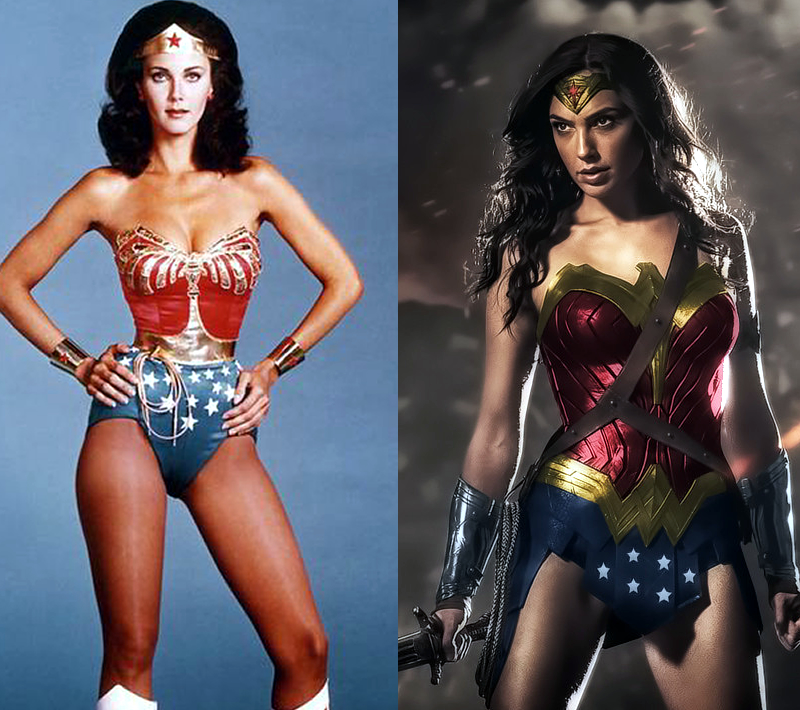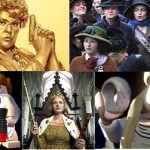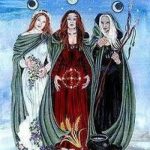We cannot live in a world that is not our own, in a world that is interpreted for us by others. An interpreted world is not a home. – Hildegard of Bingen
[Women Part 5 of 9: 1) Introduction, 2) Bodies, 3) Health, 4) Work, 5) Superwomen, 6) Religion, 7) In Tech, 8) Online 9) Conclusions]
We all love Wonder Woman, we do. My childhood memories tell me that it was the only show with a main female protagonist, and I was glued to the telly when she was on. Until I had girls, I had forgotten that I had minded about the lack of females on TV until the day I watched part of the James Bond movie Die Another Day with my girls and they kept making me replay the scenes in which Jinx was centre stage. They didn’t want to see Bond.
I didn’t want to see Bond, I wanted to see women living out loud and having adventures. I have blogged about women centre stage before, mentioning: Suffragette, Spy, Star Wars, Hunger Games and The White Queen. And, after watching the Ghostbusters (2016) the all female reboot, I was so looking forward to Wonder Woman (2017), as I was expecting a modern day women-centred interpretation of a favourite from my childhood.
What a huge disappointment. I will just state up front: Wonder Woman is a male idea of a female superhero (or self-actualised woman), which would be par for the course if it had been produced by an all male team, but it wasn’t.
Paradise Island is a male fantasy of women warriors, honestly it was only missing some mud-wrestling, and it’s so patriarchal, all those sexy women – liminal women: an extraordinary phrase used by A S Byatt and @IsabelWriter in her fabulous poetry collection Don’t ask – hanging about, waiting for Ares to come back whilst preserving (probably fondling and worshipping) relics donated by Zeus. This pressed all my patriarchal buttons until it got worse and we saw that Paradise Island has permeable boundaries, and none of these women were monitoring the perimeter. Really?
Permeable boundaries is another fabulous phrase which resonated with me when I read it first in Ann Monk Kidd’s The Dance of the Dissident’s Daughter. She says that women are trained from birth to have permeable boundaries, so we can be invaded, serve others, not listen to our own self-actualisation, etc. Nowhere to date have I seen it better demonstrated than on the Paradise Island of Wonder Woman (2017).
Hot Steve Trevor (we know this as he tells her lots of times) washes up on the shore and a glorious woman can’t take her eyes off him, even though she has lived for an eternity, and she follows him in his quest, to war: A war in which he doesn’t treat her as an equal, he tells her to be quiet, talks over her, renames her, denies her her identity and heritage, tells her how to dress, how to look, how to be, and expects her to toe the line. He then nips off to be a hero leaving her to endure a supporting role in her own movie!
The whole (clunky) plot fits right into the hero’s quest as defined by Christopher Vogler as the masculine need to overcome obstacles to achieve, conquer and possess and his updated female interpretation of the hero’s quest which sadly fits Wonder Woman’s journey in this film: Grapples with emotions as a romantic heroine, looking for the missing piece romantically. I’ll spare you the bit about homemaking. Yes please – feel the rage.
I am totally with James Cameron‘s criticism of this film when he says that she looks spectacular but seems to be designed to appeal to 14 or 18 year-old males. Looking at her half-brother Ares you don’t see him wearing a skimpy outfit which shows off his sexy form. Gods are supposed to have beautiful physiques – Diana does and add insult to injury, she is referred to as a God never a Goddess. Though, it works the other way with the female scientist – who was an anachronism if ever I saw one – she wears a mask because she is beautiful but has to be scarred to seem unattractive ‘cos she’s evil – a clumsy attempt as Chaucer put it in The Canterbury Tales as an outer manifestation of … inner characteristics. At no point does the film take us anywhere new and empowering, though it got rave reviews saying it did.
And, I get it. I do! I wanted Wonder Woman to be empowering and I wanted to write great things about it. But all it does is reminds me of those times when you want something so badly, like that job, that friendship, that interest in your book, to be good for you, and you want it so badly that you ignore the signs, you know the ones: the creepy, fake, lame behaviour which you think that with enough energy and patience you can turn into something else, but you can’t. All that happens is you feel betrayed by someone’s lack of integrity and you are left feeling that you’ve been had.
Lillian Robinson wrote a fabulous book about female super heroes called Wonder Women which aligned her joy of comics with her work as a feminist.She had lots to say about how Wonder Woman was created in 1942, and her creator Charles Moulton or William Moulton Marston had an interesting home life with his wife and children and girlfriend and children all living in the same house. Consequently, he thought Wonder Woman and her gang (which included Etta Candy) would conquer the world with some sexy lovefest which overpowers men’s need for domination and war.
Also, Wonder Woman’s magic lasso was really a symbol for using her wiles and feminine sexy powers to get a man to tell her anything. Her bracelets were to control her savageness. Anger is never accepted from any female – we have seen this from The Taming of the Shrew to Little Women’s Jo March. When women mature, they accept male domination, get behind the scenes and distract the menfolk by getting busy. Consequently, if Wonder Woman’s bracelets are chained together she loses her power, and Robinson had to wade through a lot of S&M themed editions as well as Marston’s copious lovefest fantasy notes to understand what was really going on.
Wonder Woman may be super powerful but she is not like Batman or Superman all muscly as she has to remain super sexy and attractive, with those magnificent breasts which stand up on their own in those metal breastplates. This means that she was super slim in the 40s and super toned in the 80s. She has always kept up her babe-status but is one of the rare female superheroes allowed to grow up: Super Girl for example never becomes Super Woman. She remains just a non-threatening girl. We don’t want our women fully grown, we want them malleable.
Robinson also points out that the term Superwoman is used to describe women who do everything, have a family, have a big career, run a home, which suggests potential exhaustion and no balance. There is no male equivalent. Men never talk about having it all. Men don’t need to have that conversation. So where does that leave us with self-actualised women and female superheroes?
Normally, at this point I turn to turn to Maslow’s hierarchy of needs, it explains most things. However, this time I can’t. Maslow only used two women in his group of self-actualised people, which Betty Friedan pointed out in 1963. Though, Maslow himself said he never expected the psychology community to swallow it whole and cite it indefinitely, he wanted it to be debated.
So, what I guess I am asking now is: What does a superwoman look like when viewed through a female perspective? And, what does a self-actualised woman look like look through the eyes of another self-actualised woman? I am asking because, that’s the movie that I want to see.
[6) Religion]







5 comments